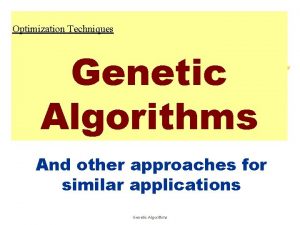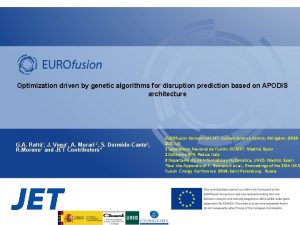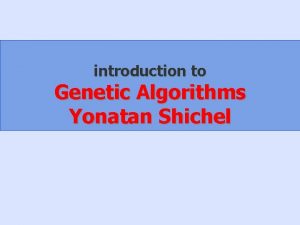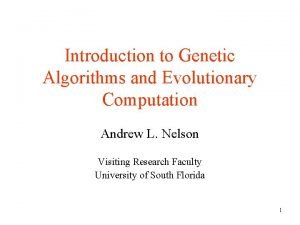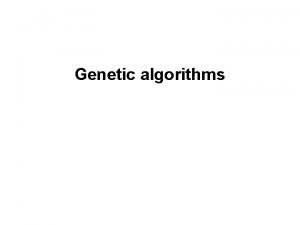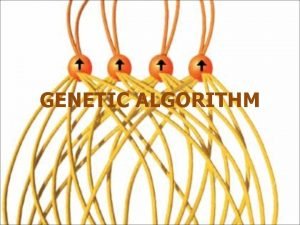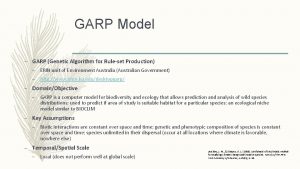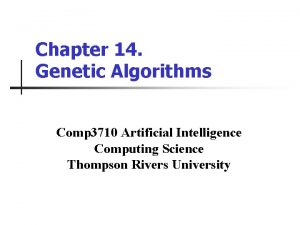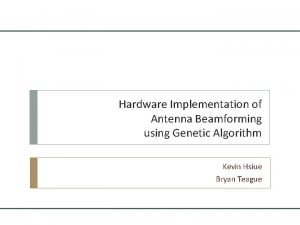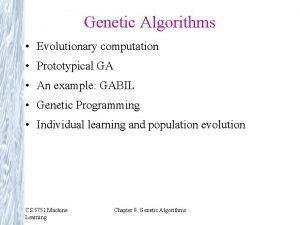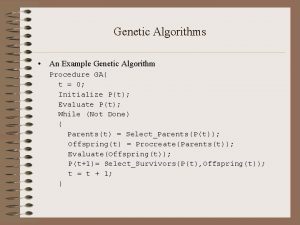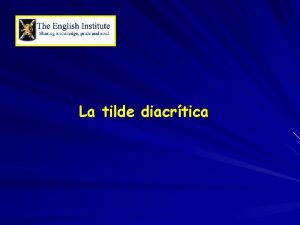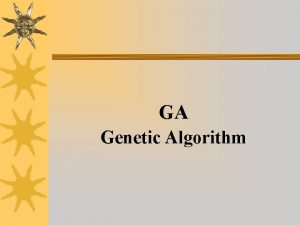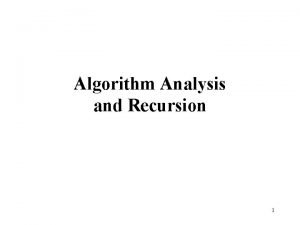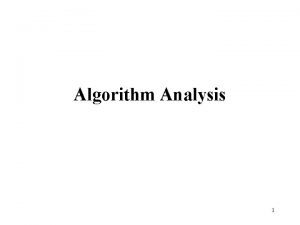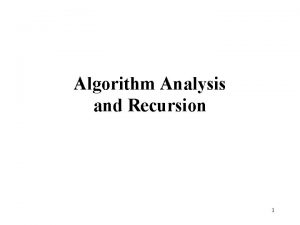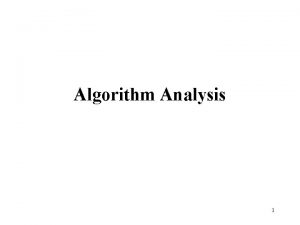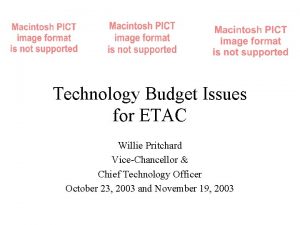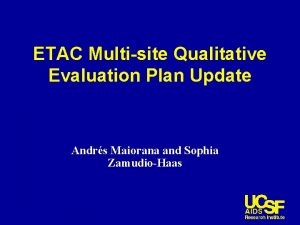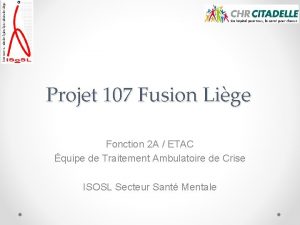THE ETAC 1 TILDE ANALYSIS USING GENETIC ALGORITHM
















- Slides: 16

THE ETA_C 1 -TILDE ANALYSIS USING GENETIC ALGORITHM ÁRON KRIPKÓ FOR THE PANDA COLLABORATION A. G. BRINKMANN 1

EXOTIC CHARMONIUM • • For hybrid charmonium states the ground state is expected to be 1 -+ spin-exotic • Flux-tube model calculations predict for a hybrid state of this mass suppressed decays to open charm with respect to hidden charm decays • An OZI-allowed decay to hidden charm would be the transition to χc 1 with emission of light hadrons, preferable scalar particles • • The lightest scalar system is composed out of two neutral pions in a relative s-wave Lattice QCD calculations predict its mass to be around 4290 Me. V with a width of 20 Me. V One of its possible decay channel is used as a benchmark channel in the TDR 2

THE DECAY TREE ~ c 1 3

CROSS-SECTION AND BRANCHING FRACTIONS 39. 41% 98. 823% 12. 348 Ge. V antiproton momentum ~ c 1 33 pb Unknow n: 100% 34. 3% 6% 4

DEDICATED BACKGROUND 5

SIMULATION AND RECONSTRUCTION • 100000 signal • 100000 x 4 dedicated background channel • 1000000 DPM events • During the event generation the PHSP model was used - all spins of particles in the initial and final state are averaged • The reworked EMC clustering algorithm was used for the reconstruction • • Better neutral reconstruction Available in the new Panda. Root release 6

GENETIC ALGORTIHM • Inspired by natural selection • Used when the evaluation of the fitness function takes many time • Individual: represents a parameter set • Mutation: randomly modify a parameter with a few percent • Cross-over: generate new individuals by taking parameters from 2 or more individuals • Selection: Delete the worst individuals 7

DIFFERENT ANALYSIS METHODS • 3 different analysis methods were tested • • • Straightforward with genetic algorythm Reconstructed TDR analysis Genetic algorythm based on the TDR analysis 8

STRAIGHTFORWARD METHOD ~ c 1 • • Combine 2 photons • Combine all muon candidates and apply a vertex fit with a mass constraint at J/ψ mass • • Combine these with a photon and apply a mass constraint fit at χc 1 mass • Feed the χ² cut values of the fits and the mass cuts on the charmonium and system to a genetic algorythm Put mass cuts on these candidates around pion and η mass with 0. 03 and 0. 5 Ge. V widths respectively Finally combine these with an eta and 2 pion candidates and perform a fit constraining the 4 -momentum at the 4 -momentum of the original -system 9

~ TDR ANALYSIS c 1 • Two photon candidates are combined and accepted as pion and η candidates if their invariant mass is within the interval 115 -150 and 470 -610 Me. V respectively • Combine all muon candidates and accept them as J/ψ if their mass is within 2. 98 -3. 16 Ge. V and apply a vertex fit with a mass constraint, • • Combine these with a photon and accept them if their mass is within the range 3. 3 -3. 7 Ge. V • • Apply a stricter mass cut on the remaining χc 1 and η candidates (3. 49 -3. 53 Ge. V and 530 -565 Me. V) Then reconstruct the initial system and perform a 4 -constraint fit and accept only those ones which have a probability > 0. 1% Perform mass constraint fits on all intermediate states except the charmonium and a new 4 constraint fit on the system created from the fitted states - a probability > 0. 1% is required at every step 10

GENETIC ALGORYTHM BASED ON THE TDR • The same procedure as previously until the first 4 -constraint fit • But the stricter χc 1 and η mass cuts and all the probability cuts are determined by the genetic algorythm 11

RESULTS Genetic TDR analysis Genetic algorythm Simulated Background 1 59 62 18 100000 Background 2 1 41 3 100000 Background 3 20 43 10 100000 Background 4 122 84 19 100000 All background 701 659 379 400000+comb. Signal 241 125 79 100000 Significance 7. 8522 4. 4643 3. 6914 FTM/√Reconstruct ed DPM Background 0 0 1 1000000 12

CHARMONIUM MASS • Extracted mass: 4. 304 +/- 0. 001 Ge. V • Extracted width: Szöveg beírásához 220 +/- 1 Me. V kattintson ide Reconstructed after the first 4 C fit FTM after the first fit Reconstructed with optimized cuts FTM with optimized cuts 13

MORE BACKGROUND • 4 · 1 million simulated dedicated background events • Background suppression: • • • 1: 6. 5 · 10⁻⁴ 2: 3. 1 · 10⁻⁵ 3: 2. 8 · 10⁻⁴ 4: 6. 3 · 10⁻⁴ DPM: less than 10⁻⁶ 14

MORE BACKGROUND • Fit the total background with the sum of a 4 th-order polinomial and a Gaussian 15

DETECTABILITY • The signal can be detected with 5 σ if the signal-background crosssection ratio is better than 1: 307. 7 16
 Genetic programming vs genetic algorithm
Genetic programming vs genetic algorithm Genetic programming vs genetic algorithm
Genetic programming vs genetic algorithm Reune lleva tilde
Reune lleva tilde Founder effect
Founder effect What is the difference between genetic drift and gene flow
What is the difference between genetic drift and gene flow Genetic drift vs genetic flow
Genetic drift vs genetic flow Single point crossover in genetic algorithm
Single point crossover in genetic algorithm Fitness function in genetic algorithm
Fitness function in genetic algorithm Single point crossover in genetic algorithm
Single point crossover in genetic algorithm Fitness function in genetic algorithm
Fitness function in genetic algorithm Is genetic algorithm heuristic
Is genetic algorithm heuristic Single point crossover in genetic algorithm
Single point crossover in genetic algorithm Genetic algorithm for rule set production
Genetic algorithm for rule set production Fitness function in genetic algorithm
Fitness function in genetic algorithm Genetic algorithm python
Genetic algorithm python Gabil genetic algorithm
Gabil genetic algorithm Schema theorem in genetic algorithm example
Schema theorem in genetic algorithm example






